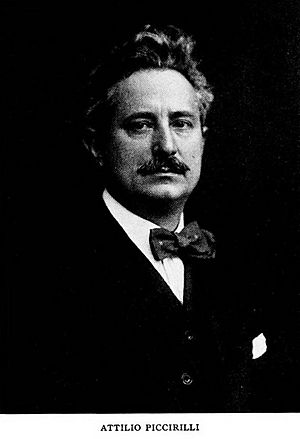Attilio Piccirilli facts for kids
Attilio Piccirilli (born May 16, 1866 – died October 8, 1945) was a famous American sculptor. He was born in Massa, Italy. He studied art at the Accademia di San Luca in Rome.
Contents
Life of a Sculptor
Attilio Piccirilli moved to the United States in 1888. He first worked with his father. Later, he joined his family's business, the Piccirilli Brothers. They had a studio in the Bronx, New York City.
The Piccirilli Brothers were very skilled. They worked as sculptors, modelers, and stone carvers. Attilio became well-known for his own art. He created the Maine Memorial in Columbus Circle, New York City. This monument is at the entrance to Central Park.
One part of the Maine Memorial was also used for his mother's grave. This grave is in Woodlawn Cemetery in the Bronx. In New York, Attilio also made sculptures for the Frick Mansion. He also created figures for the Firemen's Memorial in Riverside Park.
Working with Other Artists
Attilio Piccirilli became very important to many American sculptors. Before his family came to America, artists had to go to Italy. They went there to have their plaster models carved into stone. Attilio could take a small plaster model. Then he could create a large marble copy of it.
Most of Attilio's works were designed by other artists. For example, he helped create the famous Lincoln statue. This statue is at the Lincoln Memorial in Washington, D.C. It was first designed by Daniel Chester French.
Attilio and his family worked with many famous artists. These included Paul Bartlett and Augustus Saint-Gaudens. They also worked with architects like Cass Gilbert.
Attilio's Own Designs
Attilio also designed and sculpted many of his own works. His most famous original pieces are the Maine Monument in Central Park. Another is the Fireman's Monument on Riverside Drive. He also designed a monument to Guglielmo Marconi in Washington D.C. in 1941.
Achievements and Teaching
Piccirilli became a member of the National Academy of Design. He also joined the Architectural League. He won many awards for his art. This included a Gold Medal in San Francisco in 1915.
Attilio also helped start the Leonardo da Vinci Art School in New York City. This school aimed to offer affordable art training. It helped people who wanted to learn sculpture and other arts.
One of Piccirilli's glass sculptures was called Advance Forever, Eternal Youth. It was at Rockefeller Center in New York City. This sculpture was removed during World War Two. It later disappeared from storage.
Today, you can see Piccirilli's sculptures in many places. His work is at Brookgreen Gardens. It is also in museums across the United States. His white marble sculpture "Fragilina" is at the Metropolitan Museum of Art in New York.
Attilio Piccirilli passed away in New York City in 1945. He is buried at Woodlawn Cemetery in The Bronx.
Important Public Sculptures
Here are some of the public sculptures Attilio Piccirilli worked on:
- MacDonough Memorial, New Orleans, Louisiana, 1898
- Indian Literature and Indian Law Giver, on the Brooklyn Museum, New York, 1909
- Maine Memorial, Columbus Circle, New York, 1913
- Firemen's Memorial, Riverside Drive, New York City, 1913
- North pediment, Wisconsin State Capitol, Madison, Wisconsin, 1915
- Mothers' War Memorial, Albany, New York, 1923
- Thomas Jefferson Bust, Virginia State Capitol, Richmond, Virginia, 1931
- James Monroe Bust, Virginia State Capitol, Richmond, Virginia, 1931
- Youth Leading Industry, Rockefeller Center, New York City, 1935
- Contemporary Postman, William Jefferson Clinton Federal Building, Washington D.C., 1936
- Guglielmo Marconi Memorial, Washington, D.C., 1941
Fragilina
Fragilina is the name of a marble sculpture by Attilio Piccirilli. He finished it in 1923. The main sculpture is now at the Metropolitan Museum of Art in New York City. It is about 48 inches tall.
The word "Fragilina" in Italian means "the little delicate one." Piccirilli also made five smaller copies of this sculpture. One of these copies is at the Muscarelle Museum of Art.
The woman in Fragilina looks similar to a woman in another of his works called "A Soul." But in Fragilina, more marble is carved away. This makes the sculpture look more flowing and abstract. Some art experts have noted the oval-shaped head. They say it gives less detail to the hair and face.
Piccirilli explained his choice for the face. He said that everyone has their own idea of beauty. By not showing every detail, he let people imagine their own ideal. This shows that Piccirilli liked a simple style. He was described as a "minimalist."
A book about him says his art was "simple, and dignified." It was "free from extra details." Fragilina was shown at a big art exhibit in New York in 1923. It was also shown at another important exhibition in 1925. Piccirilli also made smaller bronze versions of Fragilina. One of these is at the Museum of Fine Arts in Boston.





